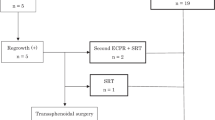Abstract
Introduction. Total removal of the tumor is the most acceptable therapeutic modality in the management of craniopharyngioma; however, there are innumerable factors that can upset treatment plans. Unresectable lesions are often treated with gamma knife surgery (GKS). Reduction of the cystic volume is necessary, to decrease the area to be treated with GKS. An Ommaya reservoir system is usually placed during open surgery or by stereotactic access.
Materials and methods. The authors use a neuroendoscope for safer and less invasive placement of the Ommaya reservoir into deep-seated cystic lesions. The cystic component is aspirated, and the Ommaya reservoir tube is precisely guided and placed into the cyst cavity under neuroendoscopic control with a newly developed two-burr-hole technique. This neuroendoscopic procedure could make it easier to reduce cystic volume prior to GKS as the final procedure. This technique may also be used for instillation of chemotherapeutic agents and for repeat aspirations, making the achievement of cystic control more likely. This type of neuroendoscopic management is a safe and effective procedure and could be considered as an alternative management technique for some stubborn cystic craniopharyngiomas.
Similar content being viewed by others
Author information
Authors and Affiliations
Additional information
Electronic Publication
Rights and permissions
About this article
Cite this article
Joki, T., Oi, S., Babapour, B. et al. Neuroendoscopic placement of Ommaya reservoir into a cystic craniopharyngioma. Childs Nerv Syst 18, 629–633 (2002). https://doi.org/10.1007/s00381-002-0638-4
Received:
Issue Date:
DOI: https://doi.org/10.1007/s00381-002-0638-4




